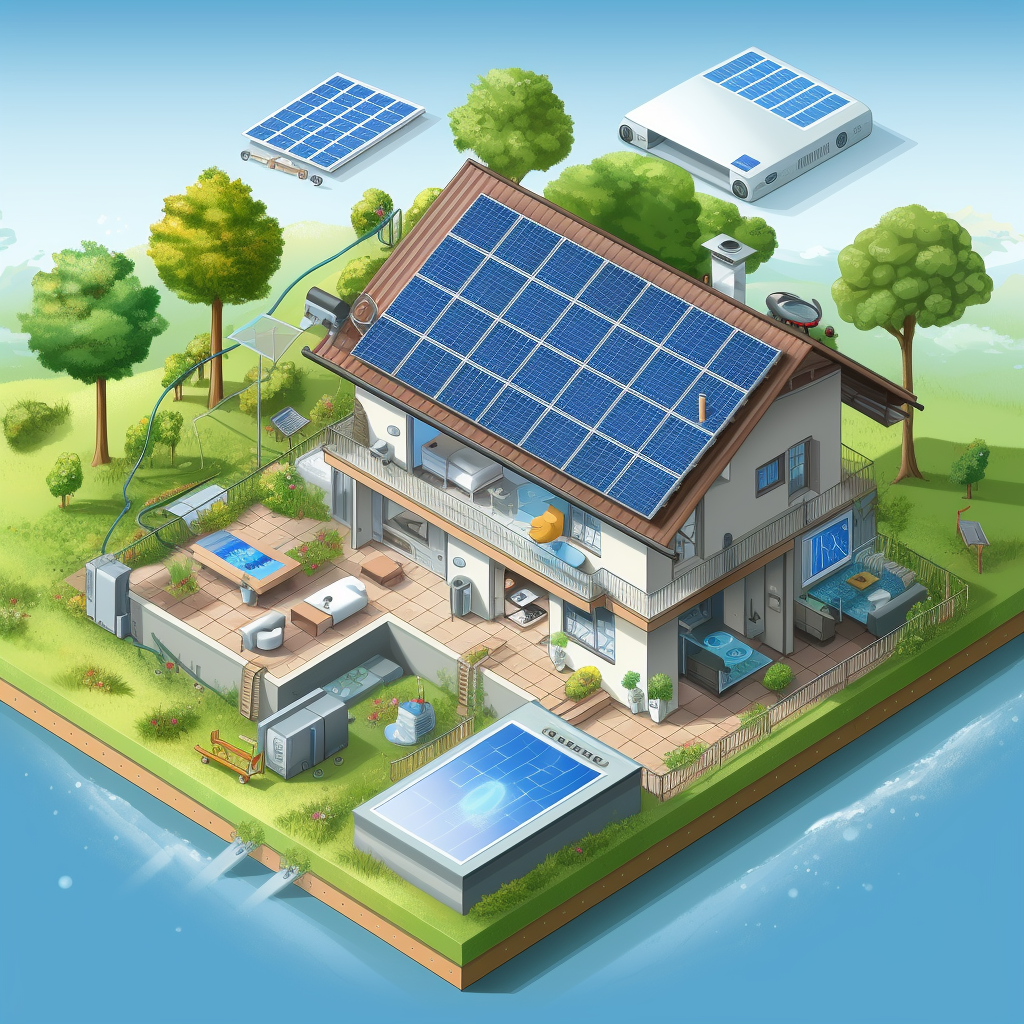

Key Takeaway:
- Solar energy systems harness the power of the sun to generate electricity: Solar energy systems consist of solar panels that convert sunlight into electricity through the photovoltaic effect. Understanding the basics of how solar panels work is essential to grasp the overall functioning of solar energy systems.
- Solar energy offers numerous benefits and applications: Solar energy is a renewable and sustainable source of power, making it environmentally friendly. It can be used for various applications, including residential, commercial, and industrial purposes, as well as for heating water and powering cars.
- The solar energy industry is rapidly growing and evolving: With advancements in technology and increasing demand for clean energy, the solar energy industry is experiencing significant growth. Staying informed about the latest trends and developments in the industry is crucial for individuals and businesses interested in solar energy.
Introduction
Solar Energy Systems: A Comprehensive Overview
Solar energy systems are an innovative and sustainable solution that harnesses the power of the sun to generate electricity. This introduction provides an insightful glimpse into the fundamental aspects of solar energy systems, shedding light on their functionality, benefits, and applications.
Solar energy systems utilize photovoltaic (PV) panels to capture sunlight and convert it into usable electricity. These systems are designed to operate efficiently even in areas with limited sunlight, thanks to advancements in solar technology. By harnessing this clean and renewable energy source, solar energy systems contribute to reducing greenhouse gas emissions and dependence on fossil fuels.
Moreover, solar energy systems have a myriad of applications, ranging from residential and commercial use to industrial and agricultural settings. They can power homes, businesses, and even entire communities, catering to diverse energy needs. Additionally, solar energy systems can be integrated into existing power grids, allowing excess electricity to be fed back into the system and reducing reliance on non-renewable energy sources.
Despite their growing popularity today, the history of solar energy systems dates back several decades. The development of modern photovoltaic technology started in the mid-20th century and gained significant momentum during the space race. Solar panels were initially used to power satellites and spacecraft in the 1950s and 1960s. Over time, advancements in efficiency, cost-effectiveness, and durability have made solar energy systems more accessible for everyday use.

The Basics of Solar Energy Systems
Solar energy systems are a vital part of sustainable energy solutions. Harnessing the power of the sun, these systems convert sunlight into usable electricity. Understanding the basics of solar energy systems is essential for individuals and communities looking to transition to renewable energy sources. By utilizing photovoltaic cells, solar energy systems capture sunlight and convert it into clean, renewable electricity. This environmentally friendly alternative offers numerous benefits, including reduced carbon emissions and energy cost savings. Additionally, the advancements in solar technology have made these systems more efficient and accessible to a wider range of consumers. Implementing solar energy systems not only contributes to a greener future but also allows individuals to take control of their energy usage and decrease reliance on traditional power sources.
One unique detail about solar energy systems is the ability to store excess electricity generated during peak sunlight hours. This stored energy can be used during periods of low sunlight or at night when there is no sunlight. Battery storage systems are commonly used to store this excess electricity, ensuring a constant and reliable power source. This aspect of solar energy systems enhances their efficiency and reliability, making them a practical choice for residential, commercial, and industrial applications.
In the true history of solar energy systems, their origins can be traced back to the 19th century when scientists discovered the photovoltaic effect. This effect involves the conversion of sunlight into electricity using certain materials such as silicon. Over the years, advancements in technology and research have led to the development of more efficient and affordable solar panels. Today, solar energy systems are gaining widespread popularity as a viable solution to combat climate change and meet growing energy demands sustainably.
Benefits and Applications of Solar Energy
Solar energy is a sustainable and promising source of power. It offers numerous benefits and applications, making it an increasingly popular choice.
Firstly, solar energy reduces reliance on fossil fuels, decreasing carbon emissions and helping combat climate change. Additionally, it provides a decentralized energy solution, allowing for off-grid electricity generation in remote areas. Solar energy systems also require minimal maintenance, reducing operating costs.
Moreover, solar power can be used in various applications such as residential, commercial, and industrial sectors, as well as for water heating and agricultural purposes. It offers a reliable and clean source of energy with a wide range of uses.
A unique detail to note is that advancements in solar technology, such as the development of more efficient solar panels, are continuously improving the efficacy and affordability of solar energy systems.
Finally, in a historical context, solar energy has been harnessed by civilizations for thousands of years, with early uses dating back to ancient China and Greece. Today, solar energy continues to evolve and play a vital role in transitioning towards a more sustainable future.
Solar Energy Industry Overview
The solar energy industry provides a comprehensive overview of the sector’s operations and development. It encompasses the various elements involved in harnessing and utilizing solar energy, including the production, distribution, and installation of solar panels and systems. This industry is driven by the increasing demand for renewable energy sources and the pursuit of sustainable energy solutions. As the world transitions towards a cleaner energy future, the solar energy industry plays a vital role in meeting the growing power needs while reducing environmental impacts. It is an industry that continues to evolve and innovate, driving advancements in solar technology and expanding its reach globally. The solar energy industry overview provides insight into the progress made and the enormous potential for further growth and adoption of solar energy as a viable alternative to traditional fossil fuels.
The solar energy industry encompasses various sectors and stakeholders, each contributing to the overall development and growth. Solar panel manufacturers play a crucial role in producing efficient and reliable solar panels that convert sunlight into electricity. These panels are then utilized in residential, commercial, and industrial applications, providing renewable energy to power homes, businesses, and infrastructure. The industry also includes solar power project developers, who identify suitable locations and design solar energy systems to meet specific energy requirements. Additionally, solar energy equipment suppliers and installers are instrumental in ensuring the seamless integration of solar systems into existing infrastructure.
Furthermore, the solar energy industry is supported by research and development efforts, which focus on improving solar panel efficiency, reducing costs, and developing advanced technologies. Government policies and incentives also play a significant role in driving the industry’s growth, as they provide financial support and regulatory frameworks to encourage the adoption of solar energy. The solar energy industry overview reflects the collective efforts of these various stakeholders and their shared goal of transitioning towards a sustainable and renewable energy future.
As the solar energy industry continues to grow, it presents tremendous opportunities for job creation and economic development. The installation and maintenance of solar energy systems require skilled workers, ranging from engineers and technicians to project managers and sales representatives. Moreover, the industry’s expansion leads to investments in local economies, supporting businesses involved in manufacturing, construction, and related services. The solar energy industry overview highlights the potential for job creation and the positive impact on regional economies as the sector continues to flourish.


Additional Resources for Solar Energy Information
With so much information available on solar energy systems, it can be overwhelming to find reliable sources. Here are three key resources to help you gather additional information on solar energy:
- Solar Energy Industries Association (SEIA) website: SEIA provides comprehensive and up-to-date information on solar energy, including market insights, policy updates, and educational resources.
- National Renewable Energy Laboratory (NREL): NREL offers a wealth of technical information and research findings on solar energy. Their website includes reports, data sets, and tools for professionals and researchers.
- US Department of Energy Solar Energy Technologies Office: This government agency provides valuable resources, such as funding opportunities, case studies, and guides for homeowners and businesses interested in solar energy.
For a more in-depth understanding, consider exploring these resources. They cover a range of topics, from industry trends to technical details and practical applications of solar energy. By accessing these additional resources, you can stay informed and make well-informed decisions about solar energy.
If you’re looking for even more insights, some other recommendations include joining online communities or forums dedicated to solar energy, attending industry conferences and workshops, and connecting with local solar energy organizations. Don’t miss out on the valuable information and opportunities available to further your knowledge and involvement in solar energy. Start exploring these resources today!
Five Facts About Understanding the Basics of Solar Energy Systems:
- ✅ The amount of sunlight that strikes the Earth’s surface in an hour and a half is enough to handle the entire world’s energy consumption for a full year. (Source: Team Research)
- ✅ Solar technologies convert sunlight into electrical energy through photovoltaic (PV) panels or mirrors that concentrate solar radiation. (Source: Team Research)
- ✅ Photovoltaic (PV) systems use solar panels to absorb sunlight and generate electricity by creating electrical charges in PV cells. (Source: Team Research)
- ✅ Concentrating solar-thermal power (CSP) systems use mirrors to reflect and concentrate sunlight onto receivers that collect solar energy and convert it to heat, which can be used to produce electricity. (Source: Team Research)
- ✅ Non-hardware costs, known as soft costs, such as permitting, financing, and installation, represent the largest share of total costs for rooftop solar energy systems. (Source: Team Research)
FAQs about The Basics Of Solar Energy Systems
Question 1: How much sunlight strikes the earth’s surface in an hour and a half?
Answer: The amount of sunlight that strikes the earth’s surface in an hour and a half is enough to handle the entire world’s energy consumption for a full year.
Question 2: What are the two main types of solar energy technologies?
Answer: The two main types of solar energy technologies are photovoltaics (PV) and concentrating solar-thermal power (CSP).
Question 3: How does photovoltaic (PV) technology work?
Answer: When the sun shines onto a solar panel with PV cells, the energy from the sunlight is absorbed by the cells, creating electrical charges that generate electricity.
Question 4: How does concentrating solar-thermal power (CSP) technology work?
Answer: CSP systems use mirrors to concentrate sunlight onto receivers. The receivers collect solar energy and convert it to heat, which can then be used to produce electricity or be stored for later use.
Question 5: What are soft costs in solar energy systems?
Answer: Soft costs refer to the non-hardware expenses associated with solar energy, such as permitting, financing, installation, customer acquisition, supplier payments, and operational costs for solar companies.
Question 6: How can solar energy benefit us?
Answer: Solar energy can reduce the cost of electricity, contribute to a resilient electrical grid, create jobs, spur economic growth, provide backup power during nighttime or outages when paired with storage, and operate efficiently on both small and large scales.




Comments (16)
Can I Use A Solar Energy Storage System In Conjunction With A Grid-tied Solar Panel Installation? - Smart Solar Reviewsays:
5 August 2023 at 19:45[…] It is crucial to ensure that the storage system is appropriately sized to meet your energy requirements. An undersized storage system may not be able to store enough energy, while an oversized system may result in unnecessary costs. It is advisable to consult with a solar energy professional to determine the optimal size for your storage system. […]
Can Solar Energy Storage Systems Be Used In Off-grid Applications? - Smart Solar Reviewsays:
5 August 2023 at 19:47[…] cycle analysis (LCA) is an essential tool for evaluating the environmental impact of solar energy storage systems. LCA assesses the energy and resource inputs, emissions, and waste generated throughout the life […]
What Is The Lifespan Of Solar Batteries Used In Energy Storage Systems? - Smart Solar Reviewsays:
5 August 2023 at 19:47[…] rates. Lead-acid batteries, lithium-ion batteries, and flow batteries are commonly used in solar energy storage systems, each with its own lifespan and performance […]
Solar Battery Watering System (24 Cell) Review - Smart Solar Reviewsays:
5 August 2023 at 19:49[…] give you a better understanding of the Solar Battery Watering System (24 Cell), here are its […]
Goal Zero Yeti 500X Portable Power Station Review - Smart Solar Reviewsays:
5 August 2023 at 19:49[…] relying on solar energy, position your solar panel in an area with maximum sunlight exposure for optimal charging […]
ADCBATT 12V 100Ah LiFePO4 Battery with Low Temp Cutoff Review - Smart Solar Reviewsays:
5 August 2023 at 19:49[…] or businesses utilizing solar power systems for their energy […]
10 Best Solar Panels for RV: Top Picks for Efficient and Sustainable Power Supply - Smart Solar Reviewsays:
5 August 2023 at 19:55[…] wattage to meet your energy needs. Additionally, consider the voltage of your RV’s battery system to ensure compatibility with the solar […]
EnginStar Solar Generator 300W Review - Smart Solar Reviewsays:
5 August 2023 at 19:55[…] give you a better understanding of the EnginStar Solar Generator 300W, here are its key […]
Best 48v Hybrid Solar Inverter - Smart Solar Reviewsays:
5 August 2023 at 19:56[…] PowMr Solar Inverter 5500W 48V is an ideal choice for off-grid solar power systems. It is designed to convert the DC electricity produced by solar panels into AC electricity that can […]
Clore Automotive Solar 1876 1000 Amp Carbon Pile Battery Load Tester Review - Smart Solar Reviewsays:
5 August 2023 at 19:57[…] give you a better understanding of the Clore Automotive Solar 1876 1000 Amp Carbon Pile Battery Load Tester, here are its […]
BougeRV MPPT Solar Charge Controller 60A Review - Smart Solar Reviewsays:
5 August 2023 at 19:58[…] give you a better understanding of the BougeRV MPPT Solar Charge Controller’s capabilities, here are some key […]
What Is The Average Charging Time For A Power Bank Using Portable Solar Panels? - Smart Solar Reviewsays:
5 August 2023 at 19:58[…] a solar tracking system can significantly improve the charging efficiency of your panel, as it maximizes the amount of […]
Are There Solar-powered Water Heating Options Available For Camping And Outdoor Use? - Smart Solar Reviewsays:
5 August 2023 at 21:22[…] can also lead to significant cost savings in the long run. While the upfront cost of installing a solar system may be higher compared to traditional water heaters, you will save money on utility bills over […]
What Are The Best Practices For Storing Solar Energy For Long-term Use In Energy Storage Systems? - Smart Solar Reviewsays:
5 August 2023 at 21:22[…] optimize the storage of solar energy in energy storage systems, several strategies can be […]
The Future is Bright: Embrace Solar Energy for a Sustainable Future - Smart Solar Reviewsays:
5 August 2023 at 21:23[…] resources and guides to help you navigate through the solar installation process seamlessly. From understanding solar incentives and financing options to finding reputable solar installers in your area, Smart […]
DOKIO 220w Solar Panel Kit Review - Smart Solar Reviewsays:
17 August 2023 at 07:02[…] give you a better understanding of the DOKIO 220w 18v Portable Foldable Solar Panel Kit, here are its […]